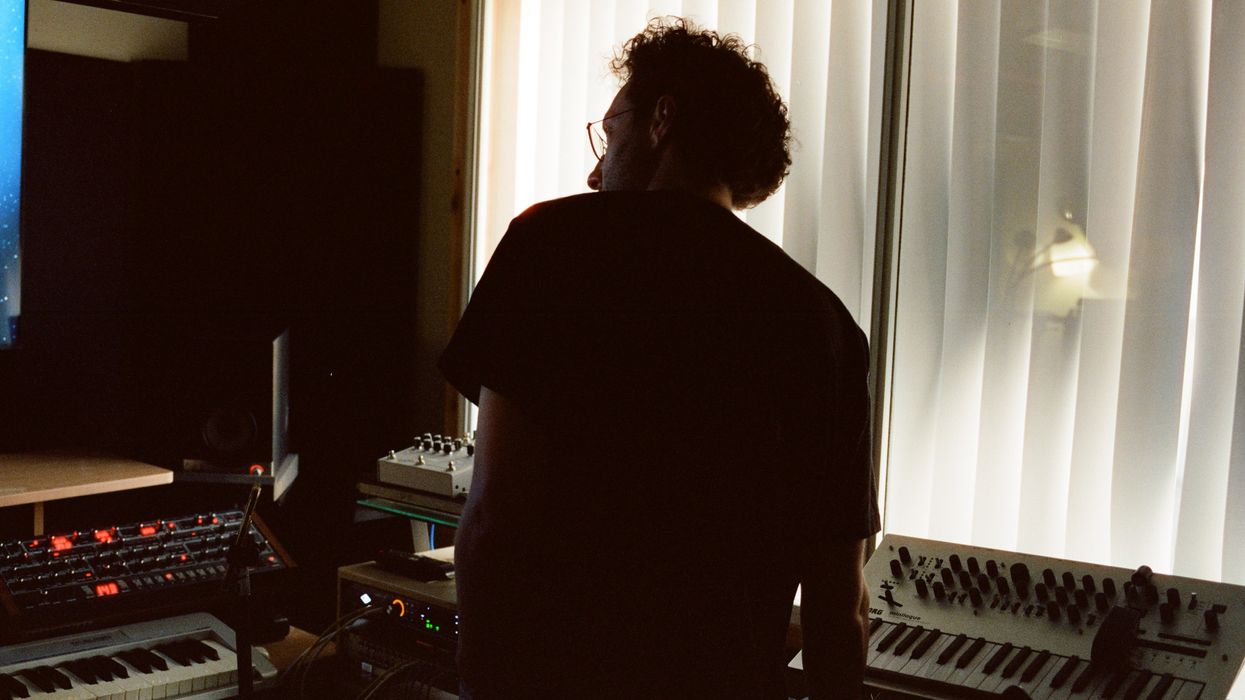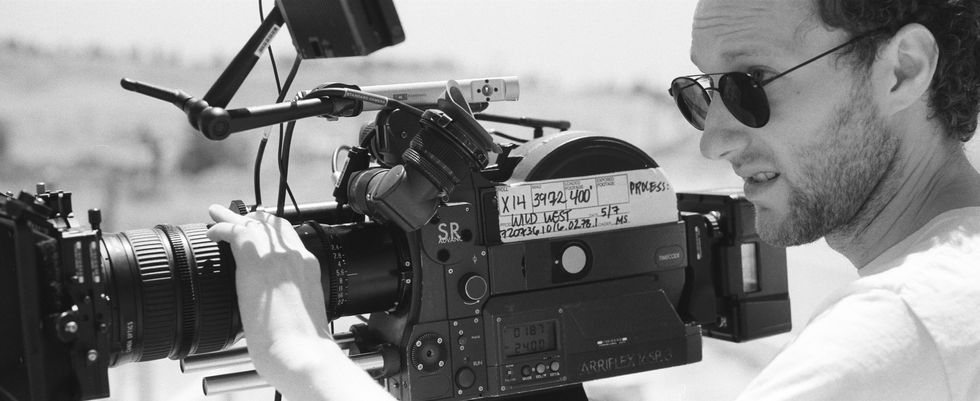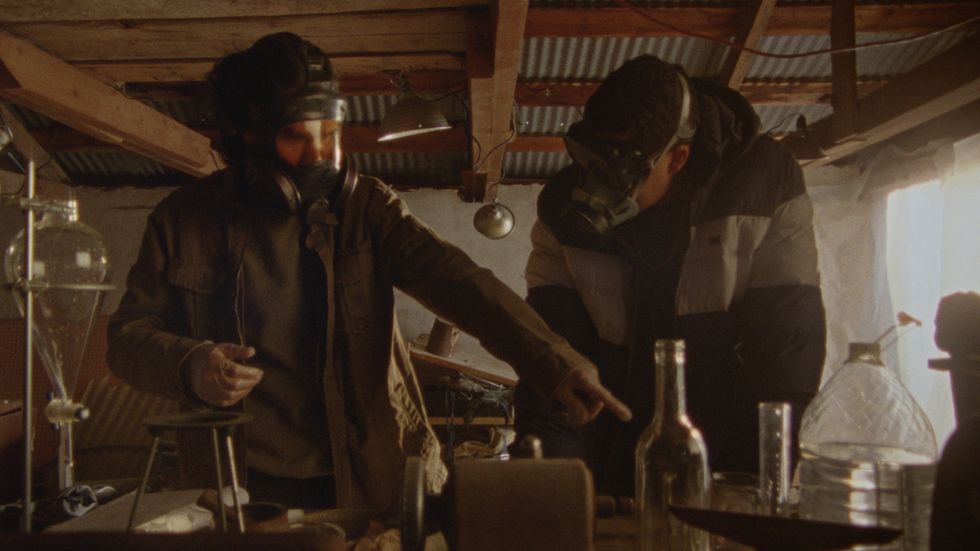How To Edit 'How to Blow Up a Pipeline'
No Film School chats with Independent Spirit Award-nominated editor Daniel Garber about his workflow for cutting How to Blow Up a Pipeline.

Daniel Garber and Daniel Goldhaber Editing How to Blow Up a Pipeline
One part heist movie, one part environmentalist takedown of the oil industry, Neon's How to Blow Up a Pipeline is a perfect example of how to use a filmic narrative structure to deliver a powerful message.
How was this balance of environmental activism told via the structure of a heist movie done to such exceptional degree, you ask? It's all in the edit, baby.
Editor Daniel Garber (up for the Independent Spirit Award for best editing, might I add) was kind enough to chat with us about his process in great detail, touching on everything from his workflow with his AE, to building the cut through dailies.
Read on for an in depth journey through the post production process of an exceptionally edited film.
The following quotes from Daniel Garber are edited clarity and readability.
The Importance of Finding the Rhythm of Workflow With Your AE

Ariela Barer, Jayme Lawson, and Sasha Lane in How to Blow Up a Pipeline
Courtesy of Neon
"The team was genuinely quite tiny, at least on the post front.
I had an assistant editor named Emily Yue, who's fantastic. What was amazing about Emily too is that she hadn't really done a lot of assistant editing work prior to Pipeline, and this was sort of a step up for her in a lot of ways.
It goes to show that if you're somebody who's a very quick learner and very willing to work hard and do your research and ask questions that you might be worried are too obvious or something, you can learn a lot very quickly and be very good at your job.
She did an excellent job of setting up the project.
What we were doing was a little bit complicated because everything was shot on 16 millimeter, so they were shooting in the desert in New Mexico and didn't have regular phone or internet access a lot of the time. They would shoot these roll of film, then ship them to FotoKem in LA where they would be scanned, and then the digital dailies would be uploaded to me, and I was based in New York, which is where we did the rest of post.
I wouldn't actually be able to look at the footage until days later, but she wanted the really rapid response, and so what would happen is they had a video tap on the camera that basically allowed them to get this low res feed that basically just captured exactly what he could see through the viewfinder.
So I would get these uploads of these really crappy low quality video tap dailies every day. I would get to look at those and say, okay, I feel like you've got what you need, or if it was really essential for me to actually clearly assess the performances, sometimes I would even have Emily sync the audio from that day to the really crappy daily so I could watch it in a little bit better context.
But then I didn't actually get to start editing in earnest until we had all the footage in from the actual lab. And so Emily would sync dailies and fill things out in Premiere, and I would just start cutting scene by scene as things came in.
So we both had these mirrored little four terabyte SSDs that we were cutting off of, and so we would make updates and send updated projects back and forth instead of operating off of the same server. So it was a little bit more asynchronous, and that also made it easier to do things like travel or cut in a different location."
How To Work in Real Time With Your Director

Daniel Goldhaber in the editing suite with Daniel Garber for How to Blow Up a Pipeline
Courtesy of Neon
"I think very often the first scene that you shoot or the first scenes that you shoot sometimes need a little something that you don't figure out until you're partway into the shoot.
And so in general, when I've been able to cut basically a day behind production, or not too long after production, it's really helped being able to say to the director, 'Hey, I feel like we could use this one additional thing.'
On Daniel Goldhaber's first feature Cam, I was on set the entire time, and we were shooting digital at the time, so that was actually a lot easier.
I could basically sit there by the monitor room and be like, 'It would be really helpful if you got an insert of the doorknob for this scene,' and then we would end up using that insert of the doorknob.
I didn't have quite as seamless of a rapport with him on this film simply because of the geographical constraints we were operating under, but still being able to frequently review the footage and say, 'Hey, I feel like the scene isn't quite working,' was really helpful.
Yeah. So we edited in Premiere this time we were using Premier Productions, which I thought was just an incredible feature that they had added in recent years and really made it rock solid."
The Balance of Script and Finding Moments in the Edit

How to Blow Up a Pipeline
Courtesy of Neon
"I think the script really did set us up for success in the edit.
There were a lot of questions that I had about the script going into the edit because there's this whole flashback structure, and I was just wondering, for so long, is this actually going to work at all? Are we going to have to fundamentally rethink the way that the flashbacks are integrated to the script?
And, as it turned out, they had thought through so many things at the writing stage. I mean, the sort of hive mind of [writers] Daniel Goldhaber and Ariela Barer and Jordan Sjol was I think very smart and really thought through a lot of the different possible consequences of structuring things in this way.
So I felt like I was already in very good hands from the beginning of the edit. There were definitely some things that changed, though. I mean, there were scenes that got cut."
Integrate Inspiration From the Heist Genre

Courtesy of Neon
"Many of our reference films were heist movies, and I mean, it's a heist of a different sort, I guess most heist have to do with the theft of something. But very often, heist movies are about people getting back at people or forces that are oppressive or that they find out of their control in some way.
Well, I guess the Oceans movies are often just about revenge in a way, but that was a major reference point for us. And then there are also films [like] Set It Off, if you've seen that. That's about a group of women bank robbers, and they come from not a lot of resources, and the bank heist is sort of a way of getting back at a system that has continually screwed them over in life.
And so I think that that sort of underdog spirit is such a big part of the heist genre. And one of the things that I think we found most appealing about the heist as a way of thinking about this particular action, but I've always loved the movies and I've always wanted to make one.
So in a way, this was kind of the perfect marriage of both ideas that I feel passionate about, and then a form of entertainment that I think is inherently really fun."
On Editing Documentary Versus Narrative

Daniel Goldhaber shooting 'How to Blow Up a Pipeline'
Courtesy of Neon
"Working in documentary sometimes keeps me honest. I think my primary interest is fiction film, but I think that I'm primarily interested in fiction films that feel like they have some sort of foot in reality in some sense.
I think that there are a lot of elements of Pipeline that feel a little documentary-esque, both in terms of how a lot of the scenes are covered from a slightly more removed camera perspective and where the camera is always following and never anticipating the action. In that sense, it feels at times like a documentary about a group of people choosing to take out this radical action. And so I think that a lot of the documentary background that I had was very helpful and just making sense of how to cut those kinds of scenes.
I think part of the issue with documentary is that it takes so long to make a documentary. It's just a really drawn out process. And so that's one thing that I find particularly draining about working in Doc. Narrative films are often much shorter edits, and if you have a longer edit, it usually means you have the freedom to really dial in what you're going for, which was sort of the case with Pipeline.
I mean, it was the better part of a year. I think it must've been about eight months total we were editing, and that's decently long for an indie film. But I think that that kind of time was really necessary just to make sure that we got really what we wanted out of the editing process."
Daniel's Advice to Editors? Trust Your Gut and Stay Humble

How to Blow Up a Pipeline
Courtesy of Neon
"Basically my two pieces of advice [or] creative guidance would be first just to always, and I feel like I'm probably just repeating something that a million editors have said before, but I think it bears repeating, which is always cut from your gut.
There are a lot of times, and I've tried to cut according to rules or what I think intellectually should work, and those have generally been very boring decisions. And the times that I've been happiest with things that I've cut at times when I feel like I've really just followed a sort of gut instinct, even if it's totally wrong.
Second thing is that it is often easier to try something out than to continue to argue about it. And that's not to say that I never argue about anything with people, but I do think that once you reach a certain level of technical proficiency, and especially if you're working in narrative film where there are sort of limited options for how to go about something, very often a director or some other collaborator will suggest a direction to take something, and you'll be surprised by how well it works, even if it seems on its face, it might not.
"I can't tell you how many times I've tried things that I thought sounded like very silly ideas only to discover that I was totally wrong. And being willing to just have that kind of humility and not stick to your guns at all times, I think is really important."
Catch How to Blow Up a Pipeline on Hulu and tune into the Independent Spirit Awards February 25













